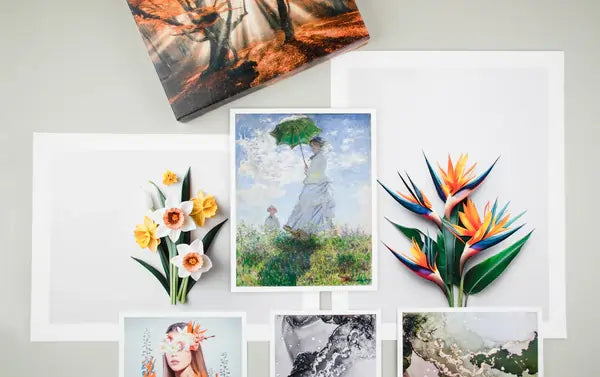
We had the pleasure of interviewing Mika Denny (pronounced Meeka), a Southern California-based figurative artist whose work beautifully captures emotion and depth. After a successful career in graphic design, she embarked on a journey of creative exploration, experimenting with painting, ceramics, and crafting. In 2018, she found her true artistic calling in figurative drawing and has been dedicated to it ever since.
Mika’s portraits blend realism with expressive depth, drawing viewers into the stories behind her subjects. Her mastery of light and shadow creates striking, emotionally rich compositions that invite curiosity and connection. In our conversation, Mika shared insights into her artistic journey, inspirations, and creative process—read on to learn more about her work and what drives her creativity.

Can you tell us a bit about your journey as an artist? What sparked your interest in art?
I was born and raised in Laguna Beach, California, a city vibrant with artistic energy. According to my mom, my love for art emerged early—she fondly remembers my obsession as a toddler with drawing teeny, tiny circles. Growing up with creative parents in a community teeming with artists, galleries, and annual art festivals was profoundly inspiring. Yet, it wasn’t just the environment; art has always felt like an intrinsic part of who I am. I was fortunate to receive a four-year scholarship from the Laguna Beach Festival of Arts to pursue a creative arts degree and earn a Bachelor of Arts in Graphic Design. I then enjoyed a decades-long career in graphic design while raising my family. However, after years of designing and creating for others, I felt the need to explore something more personal and deeply rooted in fine art. In 2018, after experimenting with painting, ceramics, and crafting, I rediscovered my first love: figurative drawing. Returning to pencil work felt like coming home. For me, art is not merely a career but a lifelong journey—a way to transform what I see and feel into something tangible. Drawing people from all walks of life allows me to express the depth and diversity of humanity, capturing the shared emotions and experiences that connect us. The joy of creation has been a steady and defining force throughout my life.
Who are your biggest artistic influences, and how have they shaped your work?
Early on, I admired the works of Alphonse Mucha, Gustav Klimt, and Tamara de Lempicka. Their ability to merge portraiture with intricate, illustrative details captivated me. Mucha’s ethereal line work and ornamentation, Klimt’s opulent patterns and symbolism, and Lempicka’s bold, elegant style left a lasting impression on me. I’ve been exploring ways to make my work unique and memorable, much like the artists who have inspired me. My charcoal portrait drawings lean toward realism but I also experiment with unexpected additions of color, line work and sometimes decorative papers. I weave these elements into my portrait work to enhance its visual impact.

Could you describe your creative process? How do you typically begin a new piece?
It always starts with the muse for me—finding that intriguing person, whether a hired life model or a stranger I approach in public. I take several photos from different angles and expressions to capture the essence of the subject. Often, I begin with a smaller preliminary sketch to explore how shadows and light interact, establishing the basic composition. I stay open to my creative instincts, deciding where to add color, decorative paper, or leave certain lines sketchy and loose. Once I'm satisfied with the sketch and have developed the overall plan, I move on to creating a larger portrait. I love watching the work evolve on paper, adding layer after layer, shifting between tight pencil work and loose pastel brushstrokes. Sometimes, as I focus closely on the small shapes and marks, they almost appear abstract. It’s when I step back and see the subject has come to life, that I often feel a deep, emotional connection. That is the part I love about creating portraits.
What are some key tools or materials you use in your work and why are they important to you?
Holding a pencil in my hand is a core memory for me. After 50-plus years, it is and will always be my favorite way of making art. Using pencils in my artwork allows me to capture fine details and subtle nuances. With the addition of PanPastel, I can contrast the precise lines of pencil with softer, more gestural marks, creating a balance between detailed drawing and a painting-like delicacy. This mix of media enhances my art by combining structure with spontaneity, which I find very appealing.

What upcoming projects are you excited about? Can you give us a sneak peek into what’s next for you?
I can't wait to get back to the drawing board! Working on more portraits for lots of exhibitions this year. I'm also applying for an exhibition opportunity that would fill up an entire summer. Fingers crossed I jury in!
Can you share a particularly memorable moment in your artistic career?
About four years ago, I created a bucket list to guide my artistic journey. In the past two years, I’ve checked off some exciting goals that have become unforgettable moments in my career. I was published in two national art magazines, including Artists Magazine as a finalist in The Best of Drawing: Strokes of Genius 15 issue, and in American Art Collector in 2024 for an exhibition I juried into at the Historic Salmagundi Art Club in New York City. I also had my first solo show, "People Watching," which led to my work being acquired by the Hilbert Museum of California Art. I took a bold step by personally inviting Founder Mark Hilbert and Director Mary Platt for a private tour of my show. I was over the moon when they said yes and subsequently purchased two of my pieces for their permanent collection. These milestones have been unforgettable and truly reflect the growth I’ve made in my career.

Where do you see your artistic journey taking you in the next five years?
I hope to exhibit my work internationally, sharing my art with a broader audience and gaining new experiences that will push my creative boundaries. I also plan to continue working through the goals on my bucket list. Ultimately, I want to keep evolving, stay true to my vision, and reach new heights while connecting with people who resonate with my art.
How do you balance the commercial aspects of being a professional artist with your creative process?
Balancing the commercial aspects of being a professional artist with my creative process can be tough. Honestly, sometimes I wish I didn’t have to deal with promoting my work at all—I’d rather just draw all day in my studio, listening to cool tunes or podcasts. Thankfully, my background as a graphic designer and creative director made creating my website and social media content manageable. But it’s all the little tasks, like shipping, entering exhibitions, and staying on top of emails, that take up time. I try to stay organized and set aside time for both the business side and my creative work, but it’s always a balancing act.

What advice would you give to artists trying to gain more exposure for their work?
My advice for artists trying to gain more exposure would be to find your tribe. Connecting with other artists can be incredibly beneficial, whether online or in person. Start by following artists you admire on social media, learning from their experiences, and attending their workshops to gain insights into their process. I personally joined an online Facebook community a few years ago, where I shared my work and received a lot of encouragement. This led to unexpected opportunities, like teaching lessons for an online school and creating my own courses. Joining a local art club is also a great way to build connections, grow your skills, and find inspiration through classes, exhibitions, and events. Not only is it rewarding to see people engage with your work, but it’s also an opportunity to meet other artists and expand your network. Explore multiple ways for your work to be seen—both in person through local exhibitions and online through art communities. You never know where it might lead!
If you could change one thing about the art industry, what would it be?
If I could change one thing about the art industry, it would be to ensure greater equality for women. While there have been strides in recent years, women artists are still often underrepresented, undervalued, and overlooked in comparison to their male counterparts. I would love to see more opportunities for women to have their voices heard, their work showcased, and their achievements celebrated on equal footing. The art world has so much diversity to offer, and embracing the full range of talent and perspectives, especially from women, would make it a more vibrant and equitable space.

How do you stay motivated and inspired to continue creating new work?
I'm continuing to look at ways to evolve my work and to add color and aspects of contemporary realism to my portraits. I'm still exploring, which makes the journey so much more interesting. I am also developing a series of drawings inspired by “Muse Encounters”. Everyday people that I meet in public places. The process of approaching strangers and asking if I can take their photo to use as a reference is scary yet thrilling, particularly when they say yes!
How has working with The Stackhouse Printery impacted your work or opened new opportunities for you?
When several people asked if I sold prints of my work, I realized it was time to figure it out. After a lot of research, I found Stackhouse Printery. Despite the distance—me in California and them in Florida—I decided to give them a try. I tested different papers and eventually fell in love with their giclée prints on photo rag paper. The quality has been outstanding, and their packaging is always perfect, especially the individual bagging and extra space around the image for my signature and edition numbering. I’ve never had to return a print because the color reproduction is always spot on. I created an online print shop for clients to order from, and I also sold many prints at my solo show. I highly recommend Stackhouse Printery and have shared their name with many other artists.
What do you think about the role of technology, like high-quality art printing, in today’s art world?
Offering high-quality prints makes my work accessible to more people who may not be able to afford an original. I'm incredibly grateful to have partnered with Stackhouse, whose support has helped my business take the next step.





